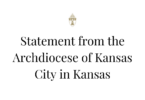by Byron Vogel
Special to The Leaven
ROELAND PARK — The ancient Japanese tradition is called “senzaburu.” It is the act of folding 1,000 paper origami cranes in order that a wish may be granted, such as recovery from a long illness.
But there is another interpretation of senzaburu — that of a family or group of people coming together to accomplish a labor of love.
And in the case of some Bishop Miege High School students, it is both.
The idea of undertaking a senzaburu came to Miege student Brian Owara, who was concerned about the mother of a classmate.
She was Terri Mika, mother of Miege students Emily and Robert Mika. Terri was facing the final days of a difficult battle with breast cancer.
“Looking at it from a Catholic standpoint, instead of the thousand cranes of hope and granting wishes, I wanted it to represent 1,000 prayers,” said Owara.
On May 4, he began to fold all 1,000 cranes on his own.
By the end of the day, he had completed just 50.
“I don’t know what came over me,” he admitted.
By the end of the next day, Owara recruited 10 more classmates for the project, and they completed 200 folded paper cranes. Word of their effort quickly spread throughout the school, and on May 6 nearly half of Miege’s 750 students joined the cause, resulting in a collection of about 1,200 cranes.
On a Saturday morning, the students gathered at Owara’s home in Kansas City, Mo., to string the cranes — many of them adorned with personal messages to the Mika family — into a sixfoot-tall mobile. The mobile was then taken to Terri Mika’s hospital room at the University of Kansas Medical Center in Kansas City, Kan.
Mika died on May 9 at the age of 45.
Today, that mobile hangs just outside the door to Miege’s campus ministry office, well in view of anyone who enters through the front doors of the school. However, it will soon return to the KU Med, where it will be on display at the hospital’s cancer center.
Miege director of campus ministry Mary Perrini praised what she described as a total grass-roots effort by the students.
“Brian came up with this idea, and the kids asked what they could do. Then it spread around the school in a day or two,” she said. “That [support] is one of my favorite things about this school.”
The thousand cranes have become a symbol for cancer, among other causes, through the story of Sadako Sasaki, a Japanese girl who died of leukemia in 1955. Her illness was the result of radiation exposure she received from the Hiroshima bombing in 1945. Statues of Sadako stand at various memorial sites around the world. Visitors often adorn the statues with 1,000 paper cranes.






